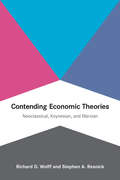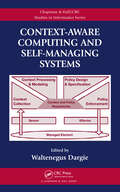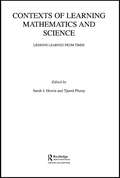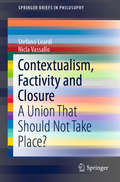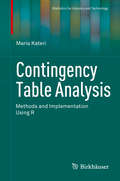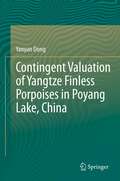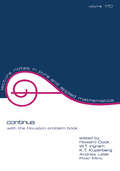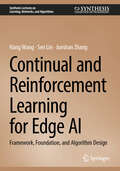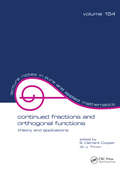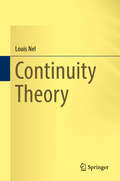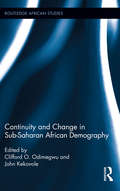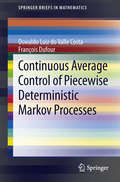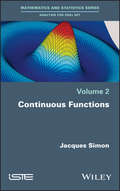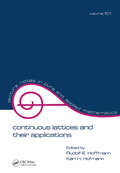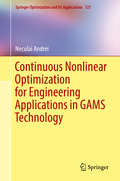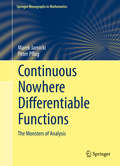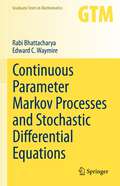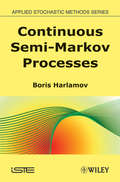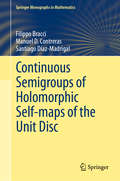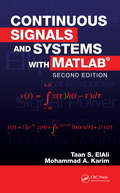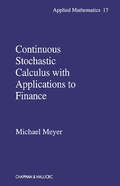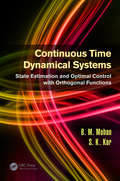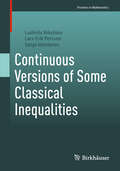- Table View
- List View
Contending Economic Theories: Neoclassical, Keynesian, and Marxian
by Richard D. Wolff Stephen A. ResnickA systematic comparison of the three major economic theories, showing how they differ and why these differences matter in shaping economic theory and practice.Contending Economic Theories offers a unique comparative treatment of the three main theories in economics as it is taught today: neoclassical, Keynesian, and Marxian. Each is developed and discussed in its own chapter, yet also differentiated from and compared to the other two theories. The authors identify each theory's starting point, its goals and foci, and its internal logic. They connect their comparative theory analysis to the larger policy issues that divide the rival camps of theorists around such central issues as the role government should play in the economy and the class structure of production, stressing the different analytical, policy, and social decisions that flow from each theory's conceptualization of economics.The authors, building on their earlier book Economics: Marxian versus Neoclassical, offer an expanded treatment of Keynesian economics and a comprehensive introduction to Marxian economics, including its class analysis of society. Beyond providing a systematic explanation of the logic and structure of standard neoclassical theory, they analyze recent extensions and developments of that theory around such topics as market imperfections, information economics, new theories of equilibrium, and behavioral economics, considering whether these advances represent new paradigms or merely adjustments to the standard theory. They also explain why economic reasoning has varied among these three approaches throughout the twentieth century, and why this variation continues today—as neoclassical views give way to new Keynesian approaches in the wake of the economic collapse of 2008.
Content-Based Image Retrieval: Ideas, Influences, and Current Trends
by Vipin TyagiThe book describes several techniques used to bridge the semantic gap and reflects on recent advancements in content-based image retrieval (CBIR). It presents insights into and the theoretical foundation of various essential concepts related to image searches, together with examples of natural and texture image types. The book discusses key challenges and research topics in the context of image retrieval, and provides descriptions of various image databases used in research studies. The area of image retrieval, and especially content-based image retrieval (CBIR), is a very exciting one, both for research and for commercial applications. The book explains the low-level features that can be extracted from an image (such as color, texture, shape) and several techniques used to successfully bridge the semantic gap in image retrieval, making it a valuable resource for students and researchers interested in the area of CBIR alike.
Context-Aware Computing and Self-Managing Systems
by Waltenegus DargieBringing together an extensively researched area with an emerging research issue, Context-Aware Computing and Self-Managing Systems presents the core contributions of context-aware computing in the development of self-managing systems, including devices, applications, middleware, and networks. The expert contributors reveal the usefulness of contex
Contexts of Learning Mathematics and Science: Lessons Learned from TIMSS (Contexts of Learning)
by Sarah J. Howie Tjeerd PlompThis book is the result of research from over fifteen countries, asking which background and environmental factors influence achievement in mathematics and science. This research is based on data from the Third International Mathematics and Science Study (TIMSS), which was conducted under the auspices of the International Association for the Evaluation of Educational Achievement (IEA) in 1995 and 1998. In many countries researchers have started secondary analysis of the data in search for relationships between contextual factors and achievement. In these analyses two different approaches can be distinguished, which can be characterised by the metaphors of ‘fishing’ and ‘hunting’. In the ‘fishing’ approach, researchers begin with an open mind, considering all possible context variables as potentially influential. Applying analysis techniques such as regression analysis, Lisrel, PLS, HLM, and MLN, they then identify important factors within their countries or across a number of countries. In the ‘hunting’ approach, researchers hypothesise certain context variables and trace the effect of these variables on mathematics and/or science achievement.
Contextualism, Factivity and Closure: A Union That Should Not Take Place? (SpringerBriefs in Philosophy)
by Nicla Vassallo Stefano LeardiThis book analyses an inconsistency within epistemic contextualism known as the factivity problem. It also provides key insights into epistemic contextualism, an important innovation in contemporary epistemology, enabling readers to gain a better understanding of the various solutions to the factivity problem. As the authors demonstrate, each explanation is based on a different interpretation of the problem. Divided into seven chapters, the book offers comprehensive coverage of this topic, which will be of major interest to philosophers engaged in epistemology and the philosophy of language. After an introductory chapter, Chapter 2 presents the most common understanding of epistemic contextualism and its semantic basis. It also clarifies the epistemological implications of the theory’s semantic assumptions. This chapter also explains the main argument of the factivity problem.The next four chapters discuss the respective solutions proposed by Wolfgang Freitag, Alexander Dinges, Anthony Brueckner and Christopher Buford, Michael Ashfield, Martin Montminy and Wes Skolits, and Peter Baumann. Stefano Leardi and Nicla Vassallo highlight the similarities and commonalities, identifying three main approaches to the factivity problem.Chapter 7 provides a brief overview of the solutions proposed to solve the factivity problem and presents an outline of the conclusions reached in the book.
Contingency Table Analysis: Methods and Implementation Using R (Statistics for Industry and Technology)
by Maria KateriContingency tables arise in diverse fields, including life sciences, education, social and political sciences, notably market research and opinion surveys. Their analysis plays an essential role in gaining insight into structures of the quantities under consideration and in supporting decision making. Combining both theory and applications, this book presents models and methods for the analysis of two- and multidimensional-contingency tables. An excellent reference for advanced undergraduates, graduate students, and practitioners in statistics as well as biosciences, social sciences, education, and economics, the work may also be used as a textbook for a course on categorical data analysis. Prerequisites include basic background on statistical inference and knowledge of statistical software packages.
Contingent Valuation of Yangtze Finless Porpoises in Poyang Lake, China
by Yanyan DongThis book presents the findings of the study, and offers analysis of both its methodological and policy-related implications. On the methodology side, it assesses and validates the valuation workshop approach; appraises the effect of distance on willingness to pay and the influence of the respondents' ability to pay. From a policy perspective, the book examines the attitudes and preference of respondents on trade-offs between economic growth and ecological use.
Continua: With the Houston Problem Book
by Howard Cook; W.T. Ingram; K.T. Kuperberg; Andrew Lelek; Piotr MincThis volume contains the proceedings of the special session on Modern Methods in Continuum Theory presented at the 100th Annual Joint Mathematics Meetings held in Cincinnati, Ohio. It also features the Houston Problem Book which includes a recently updated set of 200 problems accumulated over several years at the University of Houston.;These proceedings and problems are aimed at pure and applied mathematicians, topologists, geometers, physicists and graduate-level students in these disciplines.
Continual and Reinforcement Learning for Edge AI: Framework, Foundation, and Algorithm Design (Synthesis Lectures on Learning, Networks, and Algorithms)
by Junshan Zhang Sen Lin Hang WangThis book provides a comprehensive introduction to continual and reinforcement learning for edge AI, which investigates how to build an AI agent that can continuously solve new learning tasks and enhance the AI at resource-limited edge devices. The authors introduce readers to practical frameworks and in-depth algorithmic foundations. The book surveys the recent advances in the area, coming from both academic researchers and industry professionals. The authors also present their own research findings on continual and reinforcement learning for edge AI. The book also covers the practical applications of the topic and identifies exciting future research opportunities.
Continued Fractions and Orthogonal Functions: Theory and Applications (Lecture Notes In Pure And Applied Mathematics Ser. #154)
by S. Clement Cooper; W. J. ThronThis reference - the proceedings of a research conference held in Loen, Norway - contains information on the analytic theory of continued fractions and their application to moment problems and orthogonal sequences of functions. Uniting the research efforts of many international experts, this volume: treats strong moment problems, orthogonal polynomials and Laurent polynomials; analyses sequences of linear fractional transformations; presents convergence results, including truncation error bounds; considers discrete distributions and limit functions arising from indeterminate moment problems; discusses Szego polynomials and their applications to frequency analysis; describes the quadrature formula arising from q-starlike functions; and covers continued fractional representations for functions related to the gamma function.;This resource is intended for mathematical and numerical analysts; applied mathematicians; physicists; chemists; engineers; and upper-level undergraduate and agraduate students in these disciplines.
Continuity Theory
by Louis NelThis book presents a detailed, self-contained theory of continuous mappings. It is mainly addressed to students who have already studied these mappings in the setting of metric spaces, as well as multidimensional differential calculus. The needed background facts about sets, metric spaces and linear algebra are developed in detail, so as to provide a seamless transition between students' previous studies and new material. In view of its many novel features, this book will be of interest also to mature readers who have studied continuous mappings from the subject's classical texts and wish to become acquainted with a new approach. The theory of continuous mappings serves as infrastructure for more specialized mathematical theories like differential equations, integral equations, operator theory, dynamical systems, global analysis, topological groups, topological rings and many more. In light of the centrality of the topic, a book of this kind fits a variety of applications, especially those that contribute to a better understanding of functional analysis, towards establishing an efficient setting for its pursuit.
Continuity and Change in Sub-Saharan African Demography (Routledge African Studies #17)
by Clifford O. Odimegwu John KekovoleThis book offers an in-depth African perspective to the major issues in demographic discourse in sub-Saharan Africa. It provides comprehensive analysis of sub-Saharan African censuses, profiling demographic changes, trends, patterns and consequences in the region. Interdisciplinary, comprehensive, accessible, simple and topical, this volume is perfectly suited to researchers, students and lecturers who are interested in understanding sub-Saharan African population dynamics and issues.
Continuous Average Control of Piecewise Deterministic Markov Processes (SpringerBriefs in Mathematics)
by Francois Dufour Oswaldo Luiz CostaThe intent of this book is to present recent results in the control theory for the long run average continuous control problem of piecewise deterministic Markov processes (PDMPs). The book focuses mainly on the long run average cost criteria and extends to the PDMPs some well-known techniques related to discrete-time and continuous-time Markov decision processes, including the so-called ``average inequality approach'', ``vanishing discount technique'' and ``policy iteration algorithm''. We believe that what is unique about our approach is that, by using the special features of the PDMPs, we trace a parallel with the general theory for discrete-time Markov Decision Processes rather than the continuous-time case. The two main reasons for doing that is to use the powerful tools developed in the discrete-time framework and to avoid working with the infinitesimal generator associated to a PDMP, which in most cases has its domain of definition difficult to be characterized. Although the book is mainly intended to be a theoretically oriented text, it also contains some motivational examples. The book is targeted primarily for advanced students and practitioners of control theory. The book will be a valuable source for experts in the field of Markov decision processes. Moreover, the book should be suitable for certain advanced courses or seminars. As background, one needs an acquaintance with the theory of Markov decision processes and some knowledge of stochastic processes and modern analysis.
Continuous Functions
by Jacques SimonThis book is the second of a set dedicated to the mathematical tools used in partial differential equations derived from physics. It presents the properties of continuous functions, which are useful for solving partial differential equations, and, more particularly, for constructing distributions valued in a Neumann space. The author examines partial derivatives, the construction of primitives, integration and the weighting of value functions in a Neumann space. Many of them are new generalizations of classical properties for values in a Banach space. Simple methods, semi-norms, sequential properties and others are discussed, making these tools accessible to the greatest number of students – doctoral students, postgraduate students – engineers and researchers, without restricting or generalizing the results.
Continuous Improvement, Probability, and Statistics: Using Creative Hands-On Techniques (Continuous Improvement Series)
by William HooperWhat happens when the sport of Juggling meets a Statistical Process Control class? This book shows a creative approach to teaching data analysis for continuous improvement. Using step by step instructions, including over 65 photos and 40 graphs, traditional continuous improvement topics (design of experiments, reliability functions, and probability) are demonstrated using card illusions and hands-on activities. This book is for anyone that teaches these topics and wants to make them more understandable and sometimes even fun. Every operator, technician, student, manager, and leader can learn data analysis and be inspired to join the next generation of continuous improvement professionals.
Continuous Lattices and Their Applications
by Rudolf E. HoffmannThis book contains articles on the notion of a continuous lattice, which has its roots in Dana Scott's work on a mathematical theory of computation, presented at a conference on categorical and topological aspects of continuous lattices held in 1982.
Continuous Nonlinear Optimization for Engineering Applications in GAMS Technology (Springer Optimization and Its Applications #121)
by Neculai AndreiThis book presents the theoretical details and computational performances of algorithms used for solving continuous nonlinear optimization applications imbedded in GAMS. Aimed toward scientists and graduate students who utilize optimization methods to model and solve problems in mathematical programming, operations research, business, engineering, and industry, this book enables readers with a background in nonlinear optimization and linear algebra to use GAMS technology to understand and utilize its important capabilities to optimize algorithms for modeling and solving complex, large-scale, continuous nonlinear optimization problems or applications. Beginning with an overview of constrained nonlinear optimization methods, this book moves on to illustrate key aspects of mathematical modeling through modeling technologies based on algebraically oriented modeling languages. Next, the main feature of GAMS, an algebraically oriented language that allows for high-level algebraic representation of mathematical optimization models, is introduced to model and solve continuous nonlinear optimization applications. More than 15 real nonlinear optimization applications in algebraic and GAMS representation are presented which are used to illustrate the performances of the algorithms described in this book. Theoretical and computational results, methods, and techniques effective for solving nonlinear optimization problems, are detailed through the algorithms MINOS, KNITRO, CONOPT, SNOPT and IPOPT which work in GAMS technology.
Continuous Nowhere Differentiable Functions: The Monsters Of Analysis (Springer Monographs in Mathematics)
by Marek Jarnicki Peter PflugThis book covers the construction, analysis, and theory of continuous nowhere differentiable functions, comprehensively and accessibly. After illuminating the significance of the subject through an overview of its history, the reader is introduced to the sophisticated toolkit of ideas and tricks used to study the explicit continuous nowhere differentiable functions of Weierstrass, Takagi-van der Waerden, Bolzano, and others. Modern tools of functional analysis, measure theory, and Fourier analysis are applied to examine the generic nature of continuous nowhere differentiable functions, as well as linear structures within the (nonlinear) space of continuous nowhere differentiable functions. To round out the presentation, advanced techniques from several areas of mathematics are brought together to give a state-of-the-art analysis of Riemann's continuous, and purportedly nowhere differentiable, function. For the reader's benefit, claims requiring elaboration, and open problems, are clearly indicated. An appendix conveniently provides background material from analysis and number theory, and comprehensive indices of symbols, problems, and figures enhance the book's utility as a reference work. Students and researchers of analysis will value this unique book as a self-contained guide to the subject and its methods.
Continuous Parameter Markov Processes and Stochastic Differential Equations (Graduate Texts in Mathematics #299)
by Rabi Bhattacharya Edward C. WaymireThis graduate text presents the elegant and profound theory of continuous parameter Markov processes and many of its applications. The authors focus on developing context and intuition before formalizing the theory of each topic, illustrated with examples.After a review of some background material, the reader is introduced to semigroup theory, including the Hille–Yosida Theorem, used to construct continuous parameter Markov processes. Illustrated with examples, it is a cornerstone of Feller’s seminal theory of the most general one-dimensional diffusions studied in a later chapter. This is followed by two chapters with probabilistic constructions of jump Markov processes, and processes with independent increments, or Lévy processes. The greater part of the book is devoted to Itô’s fascinating theory of stochastic differential equations, and to the study of asymptotic properties of diffusions in all dimensions, such as explosion, transience, recurrence, existence of steady states, and the speed of convergence to equilibrium. A broadly applicable functional central limit theorem for ergodic Markov processes is presented with important examples. Intimate connections between diffusions and linear second order elliptic and parabolic partial differential equations are laid out in two chapters, and are used for computational purposes. Among Special Topics chapters, two study anomalous diffusions: one on skew Brownian motion, and the other on an intriguing multi-phase homogenization of solute transport in porous media.
Continuous Semi-Markov Processes
by Boris HarlamovThis title considers the special of random processes known as semi-Markov processes. These possess the Markov property with respect to any intrinsic Markov time such as the first exit time from an open set or a finite iteration of these times. The class of semi-Markov processes includes strong Markov processes, Lévy and Smith stepped semi-Markov processes, and some other subclasses. Extensive coverage is devoted to non-Markovian semi-Markov processes with continuous trajectories and, in particular, to semi-Markov diffusion processes. Readers looking to enrich their knowledge on Markov processes will find this book a valuable resource.
Continuous Semigroups of Holomorphic Self-maps of the Unit Disc (Springer Monographs in Mathematics)
by Filippo Bracci Manuel D. Contreras Santiago Díaz-MadrigalThe book faces the interplay among dynamical properties of semigroups, analytical properties of infinitesimal generators and geometrical properties of Koenigs functions. The book includes precise descriptions of the behavior of trajectories, backward orbits, petals and boundary behavior in general, aiming to give a rather complete picture of all interesting phenomena that occur. In order to fulfill this task, we choose to introduce a new point of view, which is mainly based on the intrinsic dynamical aspects of semigroups in relation with the hyperbolic distance and a deep use of Carathéodory prime ends topology and Gromov hyperbolicity theory. This work is intended both as a reference source for researchers interested in the subject, and as an introductory book for beginners with a (undergraduate) background in real and complex analysis. For this purpose, the book is self-contained and all non-standard (and, mostly, all standard) results are proved in details.
Continuous Signals and Systems with MATLAB (Electrical Engineering Textbook Series)
by Mohammad A. Karim Taan S. ElAliDesigned for a one-semester undergraduate course in continuous linear systems, Continuous Signals and Systems with MATLAB, Second Edition presents the tools required to design, analyze, and simulate dynamic systems. It thoroughly describes the process of the linearization of nonlinear systems, using MATLAB to solve most examples and problems. With updates and revisions throughout, this edition focuses more on state-space methods, block diagrams, and complete analog filter design.
Continuous Stochastic Calculus with Applications to Finance
by Michael MeyerThe prolonged boom in the US and European stock markets has led to increased interest in the mathematics of security markets, most notably in the theory of stochastic integration. This text gives a rigorous development of the theory of stochastic integration as it applies to the valuation of derivative securities. It includes all the tools necessar
Continuous Time Dynamical Systems: State Estimation and Optimal Control with Orthogonal Functions
by B.M. Mohan S.K. KarOptimal control deals with the problem of finding a control law for a given system such that a certain optimality criterion is achieved. An optimal control is a set of differential equations describing the paths of the control variables that minimize the cost functional. This book, Continuous Time Dynamical Systems: State Estimation and Optimal Control with Orthogonal Functions, considers different classes of systems with quadratic performance criteria. It then attempts to find the optimal control law for each class of systems using orthogonal functions that can optimize the given performance criteria. Illustrated throughout with detailed examples, the book covers topics including: Block-pulse functions and shifted Legendre polynomials State estimation of linear time-invariant systems Linear optimal control systems incorporating observers Optimal control of systems described by integro-differential equations Linear-quadratic-Gaussian control Optimal control of singular systems Optimal control of time-delay systems with and without reverse time terms Optimal control of second-order nonlinear systems Hierarchical control of linear time-invariant and time-varying systems
Continuous Versions of Some Classical Inequalities (Frontiers in Mathematics)
by Lars-Erik Persson Ludmila Nikolova Sanja VarošanecThis book presents the new fascinating area of continuous inequalities. It was recently discovered that several of the classical inequalities can be generalized and given in a more general continuous/family form. The book states, proves and discusses a number of classical inequalities in such continuous/family forms. Moreover, since many of the classical inequalities hold also in a refined form, it is shown that such refinements can be proven in the more general continuous/family frame. Written in a pedagogical and reader-friendly way, the book gives clear explanations and examples on how this technique works. The presented interplay between classical theory of inequalities and these newer continuous/family forms, including some corresponding open questions, will appeal to a broad audience of mathematicians and serve as a source of inspiration for further research.
